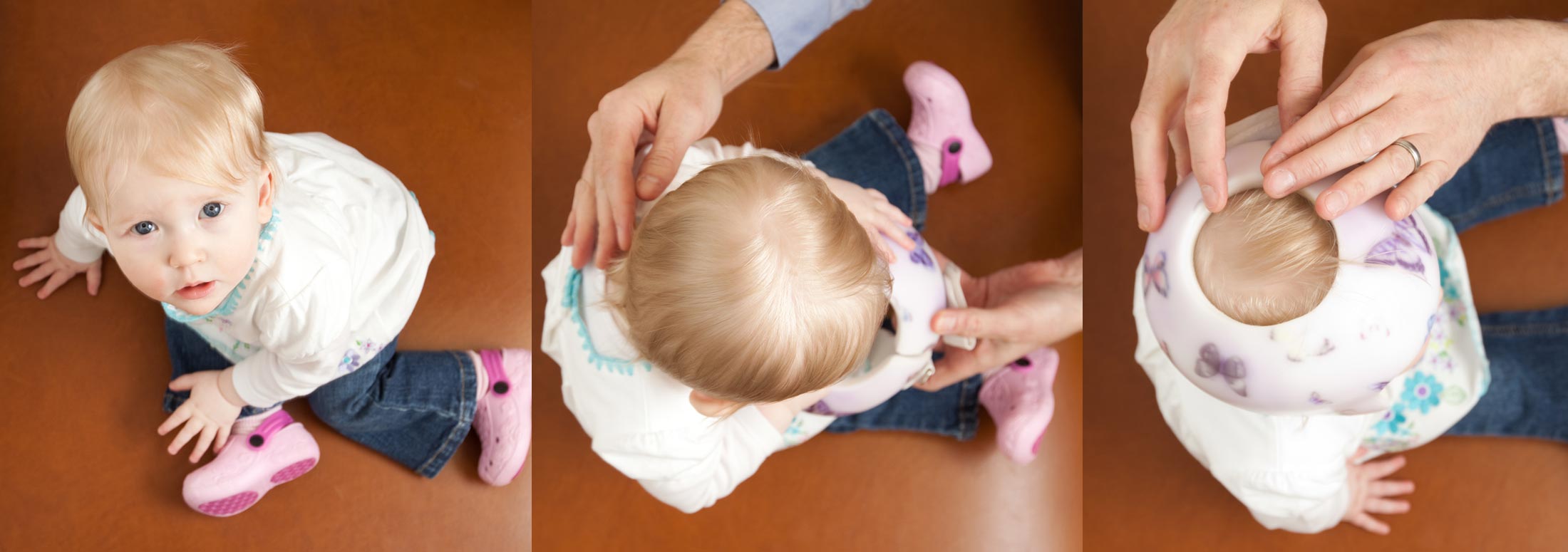Yvonne
POA Success Stories
Yvonne
An added benefit is that the helmet can also protect infants from the bumps and bruises typical with reaching milestones like standing or learning to walk.
Yvonne was a sizable baby – 9lbs 4 oz and 22” long when she arrived April 7, 2010. As her mother, Lizbeth, is a petite woman, there was limited space in the womb for Yvonne to develop.
The moment proud father Jason Silke first saw his baby’s head, he knew his professional expertise as a certified prosthetist and orthotist would be required. As an FDA certified practitioner for cranial molded helmets, Jason knew right away by looking at his daughter’s cranium that he would be making her a helmet to correct her cranial asymmetry.
“Optimally, babies are born with the bones of their skull in proportion and symmetrically placed within the four quadrants of the head,” said Jason Silke. “However, babies can experience trauma or develop deformities either while in the womb or as they travel through the birth canal, resulting in a disruption to the position of the frontal, parietal, temporal, and occipital bones.” More than just a cosmetic concern, plagiocephaly, or cranial asymmetry, could potentially impinge development of certain parts of the brain, ultimately impacting brain function.
“Left unchecked, both cranial flatness and protrusions can be exacerbated by use of infant seats and carriers as well as babies sleeping on their backs as a preventative measure against sudden infant death syndrome,” said Jason. While the incidence of SIDS has been reduced due to infants sleeping supine, there is a higher rate of cranial deformities. This has resulted in the American Academy of Pediatricians recommending the infants be placed on their stomachs while they are alert and awake during the day.
When Yvonne was six months old, her pediatrician requested that Prosthetic & Orthotic Associates create and fit a cranial remolding orthosis. Patients with cranial deformities can be seen for these corrective, custom made cranial remolding helmets at any of the company’s clinical practices throughout upstate New York.

"Once a prescription has been issued by a pediatrician, the child and their parents will come into POA for an initial consultation and to begin the insurance authorization process” said Jason. “In order to have a better outcome, it’s ideal that this process begins when the child is around six months old.” Suture lines, the joints between the various bones in the skull, will fuse by 18 months so intervention should take place prior to that.
“The second appointment consists of the capturing of the child’s exact head shape,” said Jason. While this process used to be a messy, time-consuming casting of a plaster mold of the infant’s head, which was stressful for child, parent and clinician alike, POA utilizes the latest in data acquisition technology – a 3D scanner using a non-invasive laser renders a very accurate cranial image that can be electronically delivered to an FDA-certified fabrication facility.
It typically then takes about a week before the helmet is delivered to POA and fitted to the patient on the third appointment.
It typically takes about a week before the helmet is delivered to POA and fitted to the patient on the third appointment.
Measure progress and refining fit for results
Follow-up appointments over the three months following initial delivery give the orthotist the opportunity to measure progress and refine fit to accommodate for growth. Many infants need only one or two helmets to see them through the entire cranial remolding process, the cost of which is covered by many insurance providers.
“Seeing Yvonne wearing her cranial remolding orthosis has given me a much more personal understanding of what works best in the day-to-day environment for infants wearing cranial helmets,” said Jason.
“Over the years, I’ve given recommendations to parents and physicians, but living with my daughter wearing a remolding orthosis 23-hours every day has provided insight how trim lines affect range of motion while in a prone or stomach position, how cranial helmets can protect the cranium from accidental falls or coffee table bumping and the corrective impact that it can have on the cranium.”
When Yvonne was born, her rating on the Cranial Vault Asymmetry Index, or CVAI, the rating system that determines the severity of the asymmetry, was 9.85. After nearly six months wearing the helmet, her rating has dropped to almost 0.01.
“The number one reason why infants do not present with cranial correction after receiving a cranial molded helmet is due to limited wear time because parents are concerned that this will hurt their child, or that the helmet will do more harm than good,” said Jason. “This is a proven technique that’s been used since the 1970s to correct cranial abnormalities, and there needs to be increased awareness with both the general public and the medical community that it’s an effective technique in achieving a symmetrical head."
“A properly made cranial molded helmet is just snug enough to not slide off, with a soft material inside that prevents motion, provides cushion interface and aids in suspension. An added benefit is that it can also protect infants from the bumps and bruises typical with reaching milestones like standing or learning to walk.”
“Now that I’m a parent and I’ve experienced my daughter using a cranial molded helmet, I understand even more the collaborative nature of the corrective process. Parents who work with orthotists, pediatricians and physical therapists will ensure the best clinical outcomes for their child.”